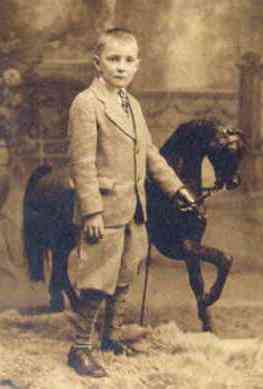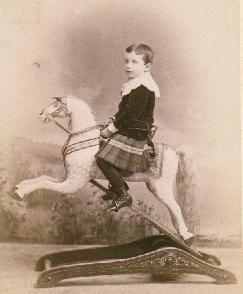
Figure 1.--This boy who looks to be about 8 or 9 years olds looks to old to be still be attached to his hobbyhorse. It appears to have been a stantionary hobby horse.


Figure 1.--This boy who looks to be about 8 or 9 years olds looks to old to be still be attached to his hobbyhorse. It appears to have been a stantionary hobby horse. |
One of the most popular toys in the nursery was the hobbyhorse. Hobbyhorse is a geneic term and there many different types in a wide variety of sizes. Some were static. Others were on rockers or springs of various designs. Some were elaborately painted and decoraed. The rocking horses may have been the best known and certainly the most prised. Stick horses may have been the most common, because they were the least expensise. They were very inexpensive. Even a boy from very humble circumstances might have a stick horse. HBC has collected some information on the different types of stick horses. There were also pull toys of different sizes.
Some hobbey horse were made without rockers, wheeks or springs. Rather they were stabtionary. Some were beautifully carved, like the horses on carosels. Others were made of fabric, rather like a stuffed animal and might have some realistic feattures. They were more stable than a rocking horse and were thus more suitable for younger boys that might find a rocking horse to much of a challenge.
Perhaps the most common and popular type of hobby horses are the ones on curved wooden rockers--similar to rocking chairs. This is the type of hobby horse that is most associated with the Victorian nursery and is the obvious inspiration for this type of toy. Some of these horses were quite elaborate with huge rockers, rather a piece of furniture. These were quite expensive items. Other rocking horse were much more basic items. Rocking horses are, however, are not always an indicator that the family was affluent because many of these images were taken in studios with a studio prop. This is usually obvious, but not always. Boys in the confines of their nurseries engaged in countless adventures, rocking away on their hobby horses. It is not clear to me how boys were dressed while rocking away on their hobby horses. Clearly many of the boys with hobby horses were still outfitted in dresses or kilts. Some boys may have also worn smocks. Many boys if breeched at about 5 years of age would have continued to enjoy their hobby horses for several years. most likely while wearing sailor suits.
Many boys but rarely girls had stick horses. The stick horse was a simple, traditional toy that never ceased to delight small children as they cantered across imaginary ranges and case to rescue a cavalry patrol surrounded by savage Indians. These wonderful traditiional toys provided hours of carefree entertainment for children of an earlier era. Stick horses had the big advantage that they were mobile and could be taken from the nursery on outings to shops or to the park. A stick horse once might have a carved wooden or other head. Usually there were painted features. Some had leather briddles and reins, perhaps with a fabric mane. The stick was normally about a meter long, actually a little shorter as the English system was more in vogue earlier and the sticks was about 32-36 incches. Some stick horses might have wheeles at the end, making them eve more mobil. The stick horse has not totally disappeared in our more sophisticated modern age. They are still available there are even stick horse rodeos. The German term is " Steckenpferd ".
Some hobby horses had wheels and were riden much as
modern chidren ride tricicles. The hobby horse descrined here by Ernest Shepard was an early wheeled hobby horse. I believe these wheeled hobby horses first appeared in the 1870s. Most of these wheeled
hobby horses appear to have been made in the 1870s and 1880s well before the turn of the century and the era of popular outdoor photography. Thus many of the images of the wheeled hobby horses were formal studio
photographs. The boy was thus dressed in his best party suit rather than his everyday clothes he wore with his wheeled horse. We know from the Sheppard book that sailor suits would be a commin outfit for boys riding wheeled hobby horses. Unfortunately little other information is currently available to the author on clothes that a boy might have actually worn while riding his hobby horse outside.

Figure 3.--This boy rides a spring hobey horse. He wears a Fauntleroy dress, note the horizontal stripes. Solid colored skirts were more common. The picture probably dates to the late 1880s or 1890s. |
Another type of hobby horse is mounted on a spring to give a little bounce when riding on it. This does not appear to have been one of the more common types of hobey horse. I have no details on actual manufacturing
statistics. Based on available images, however, this seems to have been a relatively rare type. Perhaps it was a little more dangerous for a younger todler.
One of the populat types of toys in the 19th century and early 20th century were pull toys. There were many different types of pull toys. There were commonly animals, but not always. The most popular animal was horses. These pull toys, especially the horses came in many different sizes. Some were quite small. Others were big enough to sit on, at least for a smaller child. These were primarily indoor toys, but we noteimages of children playing with them outdoors as well.
Navigate the Boys' Historical Clothing Web Site:
[Return to the Main hobbyhorse page]
[Introduction]
[Activities]
[Biographies]
[Chronology]
[Clothing styles]
[Countries]
[Theatricals]
[Bibliographies]
[Contributions]
[FAQs]
[Glossaries]
[Satellite sites]
[Tools]
[Boys' Clothing Home]
